ATR2110C Research-Grade Deep-Space Cooling Camera
1 Description and Features
The ATR2110C(ATR3CMOS02300KPA) camera is designed specifically for astrophotography. Large image area, big pixel size and high sensitivity make it suitable for night sky live broadcasting and meteor monitoring. It can be also used for deep sky photo shooting, since the camera has cooled CMOS sensor, ultra-low readout noise and zero amp-glow. Its extraordinary performance and extensive usage will give you great astrophotography experience.
The features of ATR2110C are listed below:
- SC2110 Color CMOS Sensor
- Resolution: 1920 x 1200
- 12μm Square Pixel
- 1.69-inch Optical Format
- 12-bit ADC
- 512 Mbyte Memory
- Precise Temperature Regulation
- G Sensitivity: 120000 mV/Lux s @HCG,10900 mV/Lux · s @LCG
- Zero Amp-Glow
- Ultra-Low Noise: 4 to 0.61e-@HCG
- Support High Frame Rate Mode (120 FPS at all Pixel Readout 8 bit @LCG)
- SNR Max: 50 dB
- Dynamic Range: 72 dB (Linear Mode)
- -35°C below ambient under short exposure/ -42°C under long exposure time (> 1s)
 Figure 1 SC2110 Sensor and Its Pixel Structure
Figure 1 SC2110 Sensor and Its Pixel Structure
2 ATR2110C Specifications and Performance
2.1 Camera Specifications
|
Sensor |
SmartSens SC2110 back illuminated sensor |
|
|
Diagonal |
27.4 mm |
|
|
Image Resolution |
2.3 mega pixels (1920*1200) |
|
|
Pixel Size |
12μm x 12μm |
|
|
Image Area |
23.2mm x 14.6mm |
|
|
Max FPS at Resolution (USB 3.0) |
12bit |
8bit |
|
85(LCG)/40(HCG)FPS@ 1920*1200 240(LCG)/80(HCG)FPS @ 960*600 |
120(LCG)/40(HCG)FPS @ 1920*1200 240(LCG)/80(HCG) FPS @ 960*600 |
|
|
Max FPS at Resolution (USB 2.0) |
12bit |
8bit |
|
8(LCG)/4(HCG) FPS @ 1920*1200 12(LCG)/4(HCG) FPS @ 960*600 |
12(LCG)/4(HCG) FPS @1920*1200 24(LCG)/8(HCG) FPS @ 960*600 |
|
|
Shutter Type |
Rolling shutter |
|
|
Exposure Time |
0.1ms – 3600s |
|
|
Gain |
1x – 100x |
|
|
SNR |
50 dB |
|
|
Dynamic Range |
72 dB (Linear Mode) |
|
|
Read Noise |
5.01-0.4e- |
|
|
QE Peak |
>89% |
|
|
Full Well |
17ke- |
|
|
ADC |
12bit |
|
|
DDR3 Buffer |
512MB (4Gb) |
|
|
Connection Port |
USB3.0/USB2.0 |
|
|
Camera Adaptor |
M42 x 0.75mm |
|
|
Protect Windows |
IR-cut filter/AR-window |
|
|
Spectral Range |
380-690nm (with IR-cut filter) |
|
|
Capture/Control SDK |
Windows/Linux/macOS/Android Multiple Platform SDK (Native C/C++, C#/VB.NET, Python, Java, DirectShow, Twain, etc.); |
|
|
Recording System |
Still picture and movie |
|
|
Camera Dimensions |
Diameter 80mm * height 107.1mm |
|
|
Camera Weight |
0.577kg |
|
|
Back Focus Distance |
17.5mm |
|
|
Cooling: |
Two stage TEC |
|
|
Effective Cooling Temp: |
-35°C below ambient under short exposure/ -42°C under long exposure (> 1s) |
|
|
Supported OS |
Microsoft® Windows® XP / Vista / 7 / 8 / 10 / 11 (32 & 64 bit) OS x (Mac OS X) Linux |
|
2.2 SmartSens SC2110 QE Curve
The sensor G Sensitivity of ATR2110C is 120000 mV/Lux·s @HCG,10900 mV/Lux·s @LCG . Its QE Curve is shown in Figure 2.
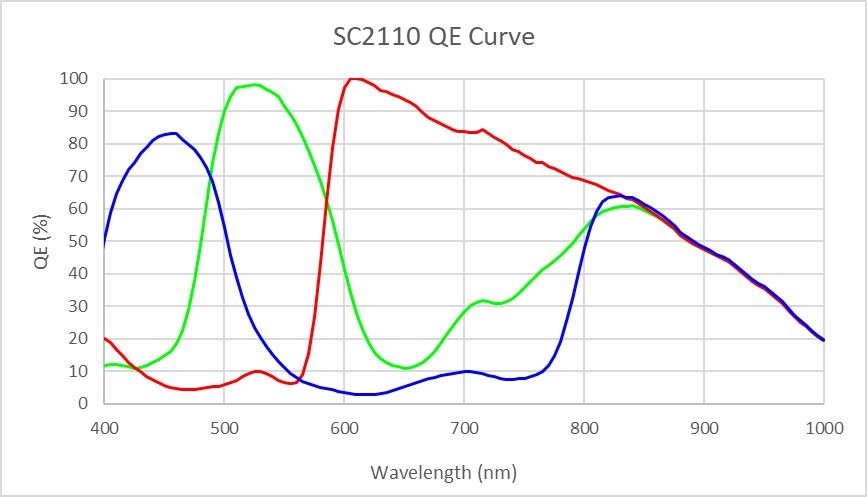 Figure 2 SC2110 QE Curve
Figure 2 SC2110 QE Curve
2.3 12bit ADC and ROI
ATR2110C has built in 12bit ADC. It also has 12bit output mode for hardware binning and smaller resolution. The camera also supports hardware ROI, and the smaller the ROI size is, the higher the frame rate is.
Table 2 shows the frame rate of ATR2110C in 12/8bit mode, USB3.0 / USB2.0 data transfer interface at different resolutions:
|
Bit & Interface FPS Resolution |
12bit ADC |
8bit ADC |
||
|
USB3.0 |
USB2.0 |
USB 3.0 |
USB 2.0 |
|
|
1920*1200 |
85(LCG) 40(HCG/HDR) |
8(LCG) 4(HCG/HDR) |
120(LCG) 40(HCG/HDR) |
12(LCG) 4(HCG/HDR) |
|
960*600 |
240(LCG) 80(HCG/HDR) |
23(LCG) 8(HCG/HDR) |
240(LCG) 80(HCG/HDR) |
24(LCG) 8(HCG/HDR) |
2.4 DDR3 Buffer
The ATR2110C camera has a 512MB (4Gb) DDR3 buffer, which helps maintain the stability of data transmission, and effectively reduce the amp-glow caused because image data can be temporarily buffered without being sent hastily to the receiver.
2.5 Binning
ATR2110C supports digital binning from 1x1 to 8x8 in either stacking or averaging method, and hardware binning from 1x1 to 2x2 in averaging method. Hardware pixel binning is much faster than software binning.
2.6 Conversion Gain Switch
ATR2110C supports HCG , LCG and HDR mode switch.
2.7 Power and Cooling System for Precise Temperature Regulation
Please remember, the Camera can be powered only by DC12V 3A power source.
The cooling system of ATR2110C is two-stage Thermoelectric Cooling (TEC) with controllable electric fan assisting heat dissipation.
The TEC system is controlled by PID algorithm, which allows the TEC to be precisely regulated towards the target temperature with 0.1°C deviation.
The working temperature can be regulated to specific number, and effective temperature drop can be -42°C from ambient temperature. Such efficient cooling system guarantees the stability of camera image and its quality.
2.8 Zero Amp-Glow
ATR2110C has been carefully designed and is able to achieve zero amp-glow photo shooting. Figure 3 and Figure 4 show the different cameras at 20°C and 5-minute exposure time with and without amp-glow. By comparison, the image captured by ATR2110C shows zero amp-glow.
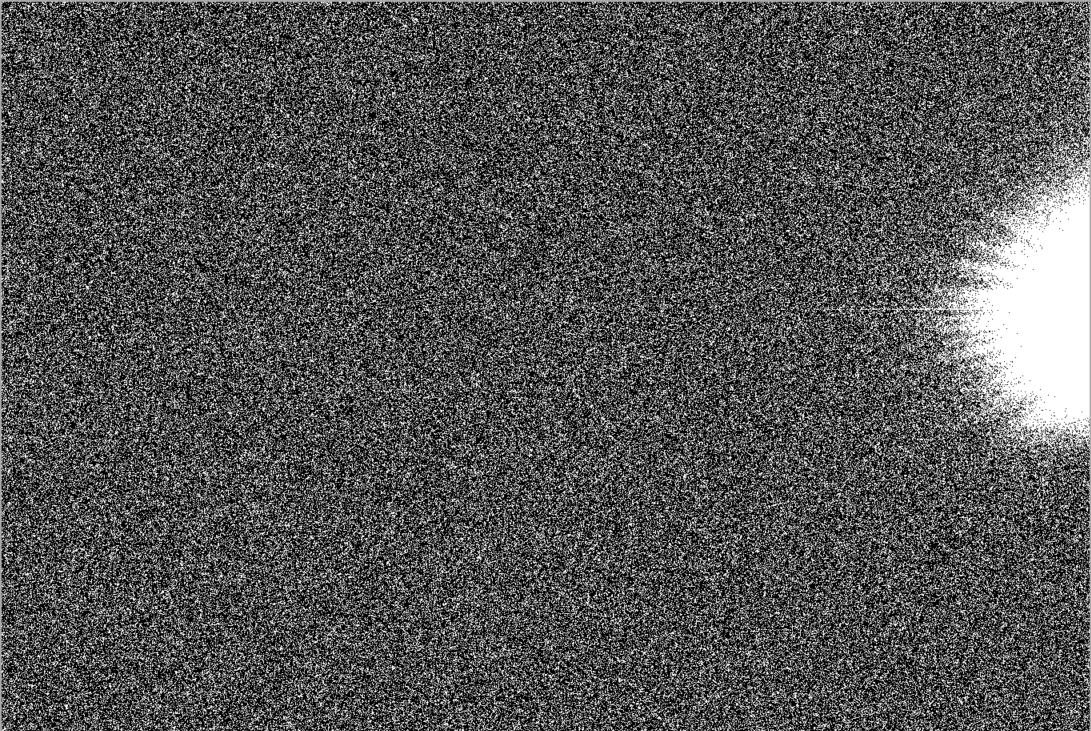 Figure 3 Amp-glow
Figure 3 Amp-glow
|
 Figure 4 Zero amp-glow
Figure 4 Zero amp-glow
|
2.9 Camera Performance Analysis
Camera performance can be evaluated with e-/ADU, Read Noise, Full Well and Dynamic Range.
e-/ADU: The sensors found in cameras used for vision applications have pixels that convert incoming photons into electrons. Gain on a CCD /CMOS camera represents the conversion factor from electrons (e-) into digital counts, or Analog-Digital Units (ADUs). Gain is expressed as the number of electrons that get converted into a digital number, or electrons per ADU (e-/ADU).
Read Noise: Read Noise is created within the camera electronics during the readout process as the electrons are subjected to the analog to digital conversion, amplification and processing steps that enable an image to be produced. Read Noise is the most important reference to measure the performance of a camera. Lower read noise usually means better SNR and better quality of image.
Full Well: The electrons are held in each pixel and are converted into electrical charge which can be measured to show the amount of light that has fallen on each pixel. The maximum electrical charge possible is termed "full well capacity". Under the same conditions such as noise and A/D converter quality, the greater full well capacity a sensor has, the wider dynamic range the sensor has. As there is a limit to the depth to which pixels can be made, the full well capacity is often proportional to the frontal area of the light gathering element of the pixel.
Dynamic Range: Dynamic range is the ratio between the maximum output signal level and the noise floor at minimum signal amplification (noise floor which is the RMS (root mean square) noise level in a black image). The noise floor of the camera contains sensor readout noise, camera processing noise and the dark current shot noise. Dynamic range represents the camera’s ability to display/reproduce the brightest and darkest portions of the image and how many variations in between. This is technically intra-scene dynamic range. Within one image there may be a portion that is in complete black and a portion that is completely saturated.
For the ATR series camera, the Gain Value is in xxx% mode. Here xxx is used as the x axis (Gain Value) for the description of the camera performance
All following data were acquired in SharpCap with ASCOM driver:
Camera setting used for HCG performance analysis is shown below:
- Full resolution
- RAW 12-bit mode
- Temperature: -10°C
Figure 5 shows the curves of the camera analysis data in Table 3
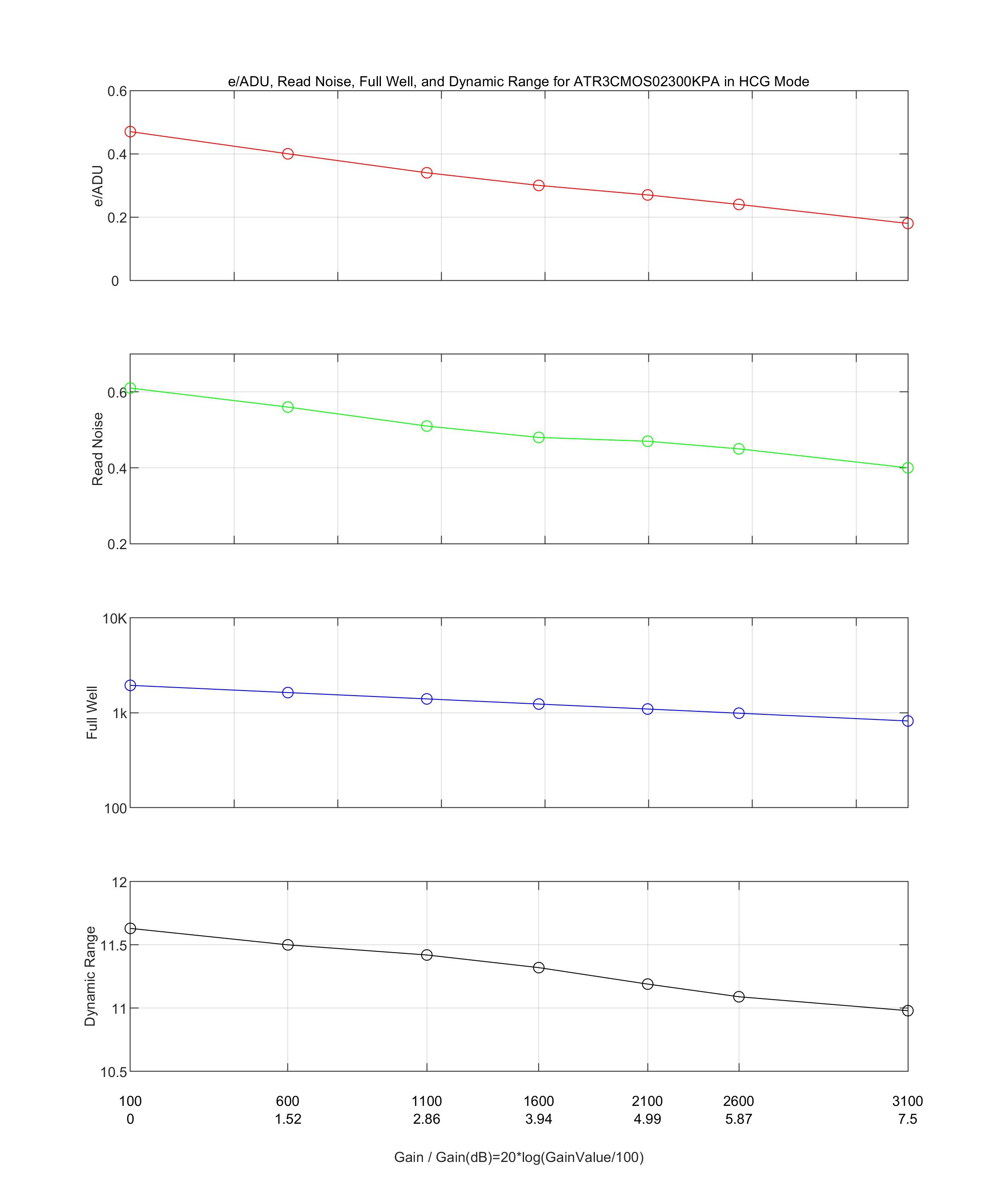 Figure 5 e/ADU, Read Noise, Full Well and Dynamic Range for ATR2110C
Figure 5 e/ADU, Read Noise, Full Well and Dynamic Range for ATR2110C
The camera analysis data is shown in Table 3:
|
Sensor Analysis Data |
|||||||
|
Gain Value |
100 |
600 |
1100 |
1600 |
2100 |
2600 |
3100 |
|
Rel Gain (dB) |
0.00 |
1.52 |
2.86 |
3.94 |
4.99 |
5.87 |
7.5 |
|
e-/ADU |
0.47 |
0.4 |
0.34 |
0.3 |
0.27 |
0.24 |
0.18 |
|
Read Noise (e-) |
0.61 |
0.56 |
0.51 |
0.48 |
0.47 |
0.45 |
0.4 |
|
Full Well (ke-) |
1.9 |
1.6 |
1.4 |
1.2 |
1.1 |
1 |
0.8 |
|
Dynamic Range (stop) |
11.63 |
11.5 |
11.42 |
11.32 |
11.19 |
11.09 |
10.98 |
Camera setting used for LCG performance analysis is shown below:
- Full resolution
- RAW 12-bit mode
- Temperature: -10°C
Figure 6 shows the curves of the camera analysis data in Table 4
 Figure 6 e/ADU, Read Noise, Full Well and Dynamic Range for ATR2110C
Figure 6 e/ADU, Read Noise, Full Well and Dynamic Range for ATR2110C
The camera analysis data is shown in Table 4 :
|
Sensor Analysis Data |
|||||||
|
Gain Value |
100 |
600 |
1100 |
1600 |
2100 |
2600 |
3100 |
|
Rel Gain (dB) |
0.00 |
1.4 |
2.73 |
3.8 |
4.83 |
5.71 |
7.29 |
|
e-/ADU |
8.43 |
7.18 |
6.16 |
5.44 |
4.83 |
4.37 |
3.65 |
|
Read Noise (e-) |
5.01 |
4.87 |
4.81 |
4.54 |
4.28 |
4.11 |
3.67 |
|
Full Well (ke-) |
17.2 |
14.7 |
12.6 |
11.2 |
9.9 |
9 |
7.5 |
|
Dynamic Range (stop) |
11 |
11 |
11 |
11 |
11 |
11 |
10.99 |
Camera setting used for HDR performance analysis is shown below:
- Full resolution
- RAW 12-bit mode
- Temperature: -10°C
Figure 7 shows the curves of the camera analysis data in Table 5
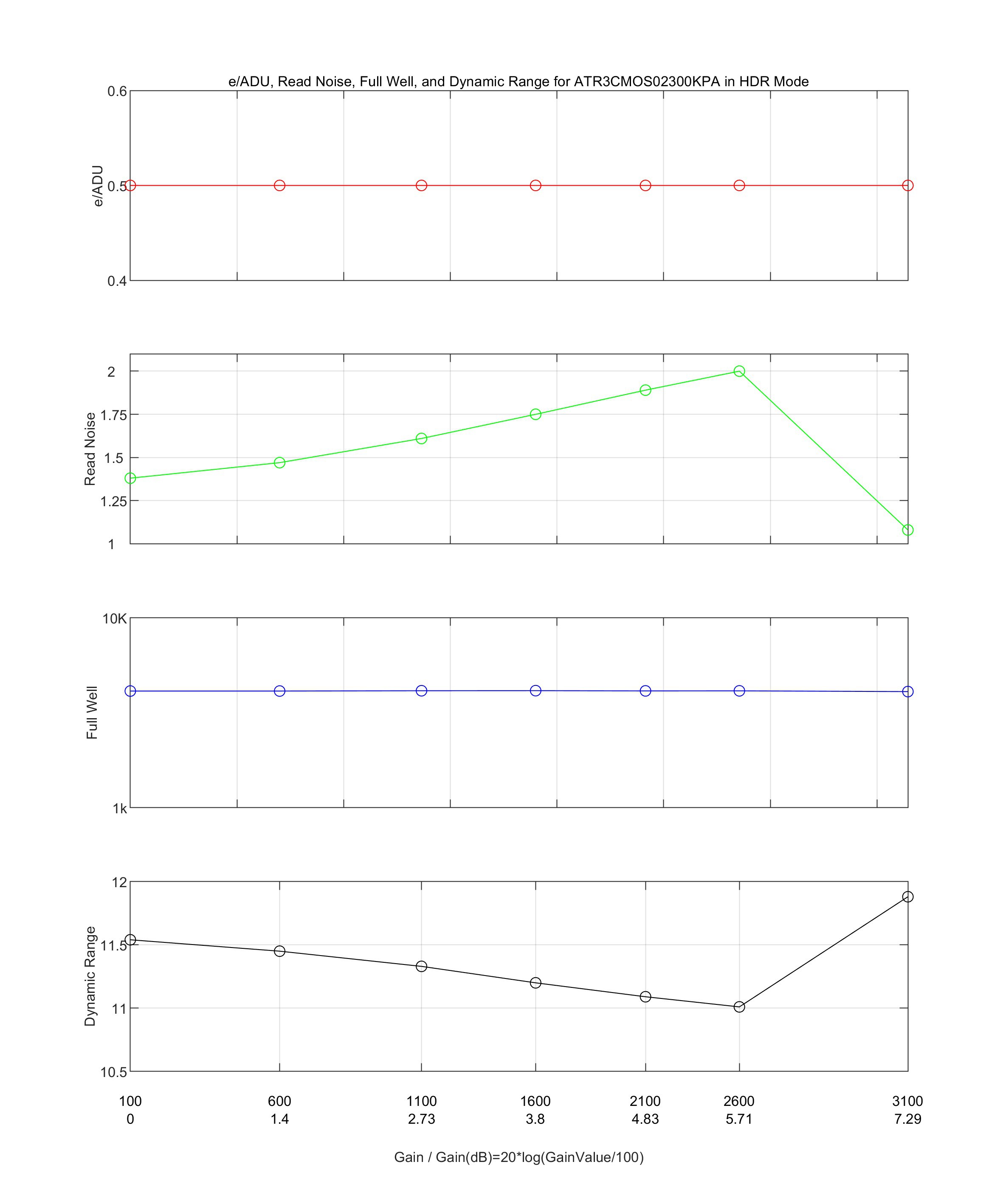 Figure 7 e/ADU, Read Noise, Full Well and Dynamic Range for ATR2110C
Figure 7 e/ADU, Read Noise, Full Well and Dynamic Range for ATR2110C
The camera analysis data is shown in Table 5
|
Sensor Analysis Data |
|||||||
|
Gain Value |
100 |
600 |
1100 |
1600 |
2100 |
2600 |
3100 |
|
Rel Gain (dB) |
0.00 |
1.4 |
2.73 |
3.8 |
4.83 |
5.71 |
7.29 |
|
e-/ADU |
0.5 |
0.5 |
0.5 |
0.5 |
0.5 |
0.5 |
0.5 |
|
Read Noise (e-) |
1.38 |
1.47 |
1.61 |
1.75 |
1.89 |
2 |
1.08 |
|
Full Well (ke-) |
4.1 |
4.1 |
4.1 |
4.1 |
4.1 |
4.1 |
4.1 |
|
Dynamic Range (stop) |
11.54 |
11.45 |
11.33 |
11.2 |
11.09 |
11.01 |
11.88 |
3 Product Package and Connections
3.1 Packing List
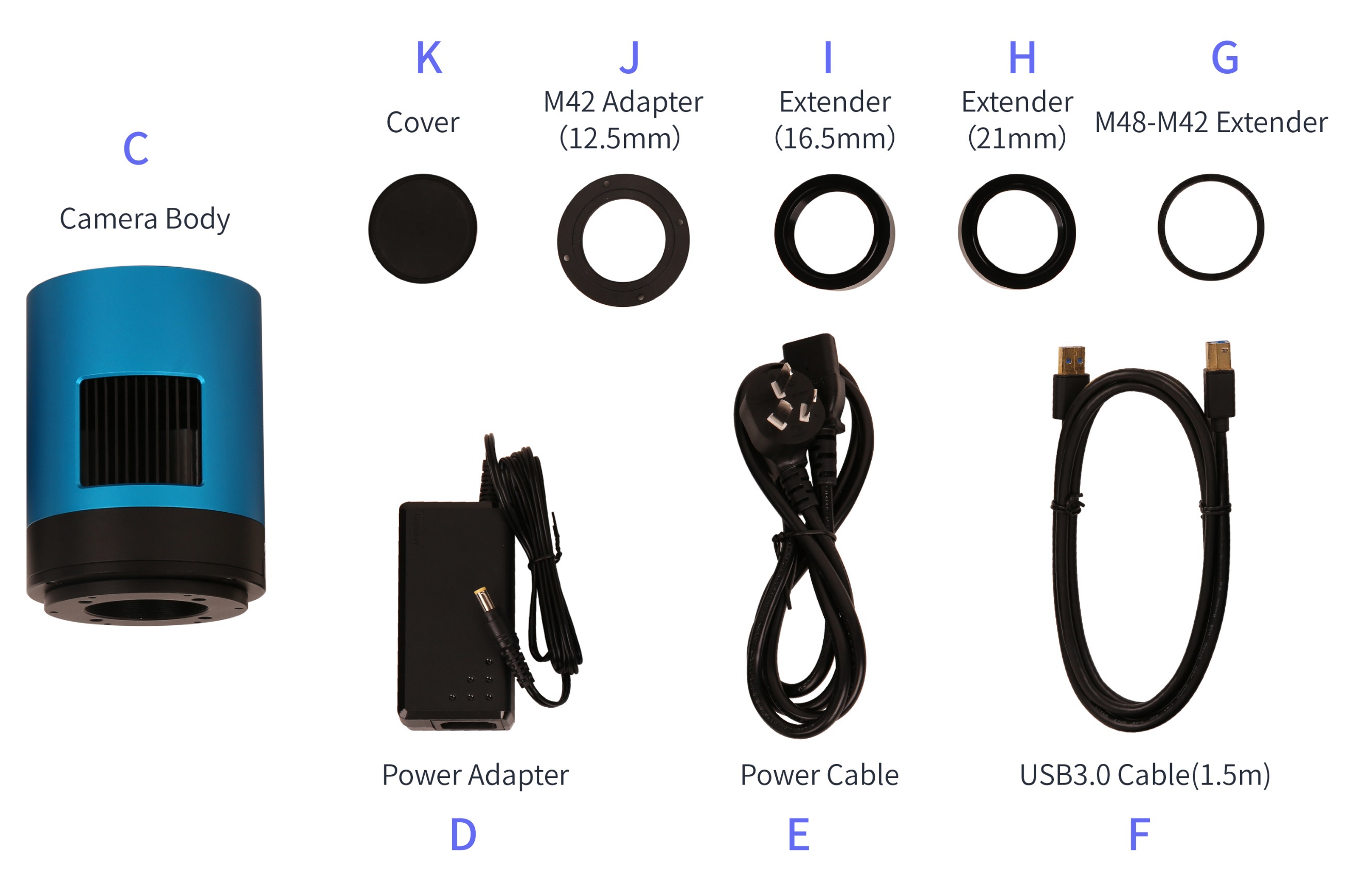 Figure 8 Packing Information of ATR2110C
Figure 8 Packing Information of ATR2110C
|
Standard Package |
|
|
A |
Carton L:50cm W:30cm H:30cm (20pcs, 12~17Kg/ carton, 0.045m3), not shown in the photo |
|
B |
3-A safety equipment case: L:28cm W:23cm H:15cm (1pcs, 3.9Kg/ box); carton size: L:28.2cm W:16.7cm H:25.5cm (TBD), not shown in the photo |
|
C |
ATR series camera (M42x0.75 Mount+2” adapter) |
|
D |
Power adapter: input: AC 100~240V 50Hz/60Hz, output: DC 12V 3.3A |
|
E |
Power cable |
|
F |
High-Speed USB3.0 A male to B male gold-plated connectors cable /1.5m |
|
G |
M48-M42 extender 0mm |
|
H |
M42M-M42F extender 21mm (TBD) |
|
I |
M48F - M42M extender 16.5mm (TBD) |
|
J |
M42M adapter 12.5mm |
|
K |
Cover |
3.2 Camera Dimension and Its Mount
 Figure 9 Dimension and Mount of ATR2110C
Figure 9 Dimension and Mount of ATR2110C
|
Item |
Specification |
|
Diameter |
Æ80mm |
|
Height |
107.1mm |
|
Mount |
M42Fx0.75mm |
3.3 Camera Outline and Interface
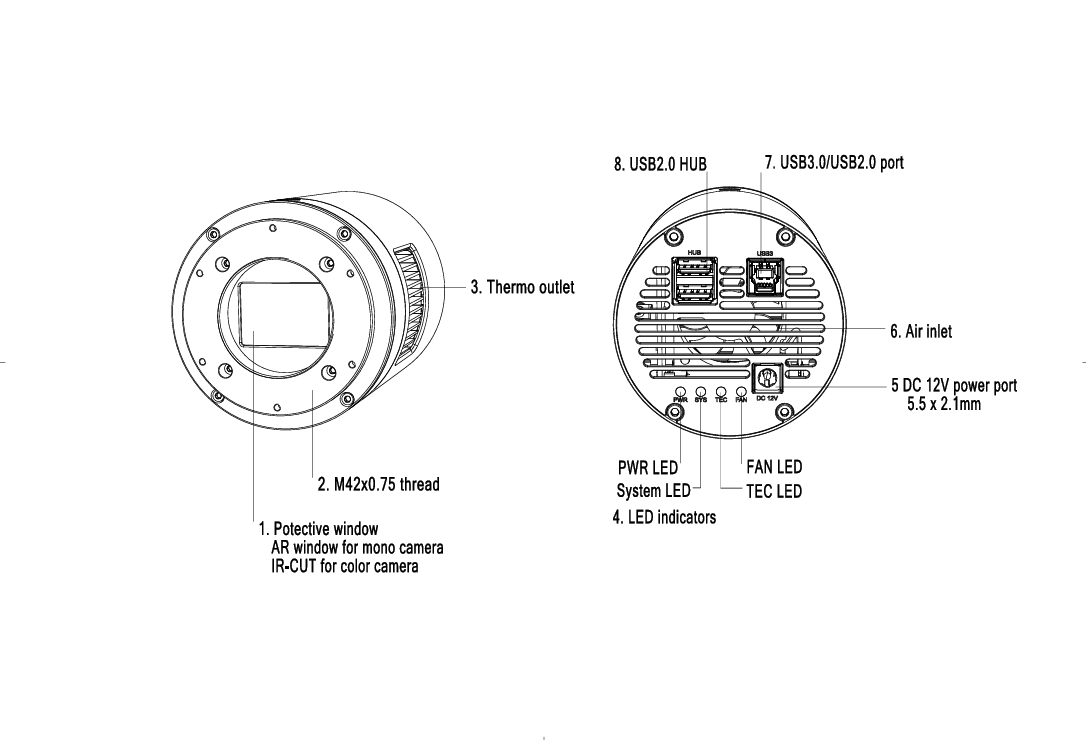 Figure 10 Camera Outline and Interface.
Figure 10 Camera Outline and Interface.
|
Item |
Specification |
|
1 |
Protective window, AR window for mono camera, IR-cut filter for color camera |
|
2 |
M42F x 0.75 thread |
|
3 |
Thermal outlet or radiator |
|
4 |
LED indicators: 1) Power LED. 2) System LED. 3)TEC LED. 4)Fan LED |
|
5 |
DC 12V 3A power port, 5.5 x 2.1mm |
|
6 |
Air inlet |
|
7 |
USB 3.0/ USB 2.0 port |
|
8 |
USB 2.0 HUB |
3.4 Camera Mechanical Connection with Adapter
ATR2110C can be connected to a telescope with proper adapter, or the camera lens. The most common adapters are already included in the package, but we also provide some specific adaptors based on the requirement.
The female flange to the sensor is 17.5mm. ATR2110C comes with M42x0.75 mount and can connect to telescope with the M42x0.75 thread in a direct way.
ATR2110C can also connect to the telescope who use 1.25” or 2” eyepieces by M42M-1.25” or M42M-2” adapter. Figure 10 shows the connection of the camera and the adapter. After the adapter is screwed to the camera, the camera can insert into the telescope’s eyepiece tube. Table 8 list the details of the camera and adapter parameters.
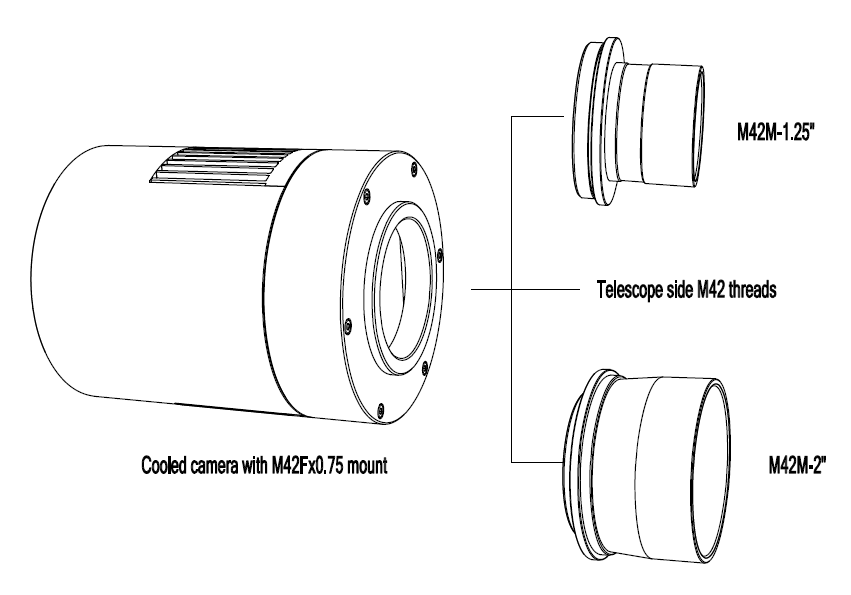 Figure 11 The Connection of the ATR Camera and Adapter
Figure 11 The Connection of the ATR Camera and Adapter
|
Item |
Specification |
|
Back Focal Distance |
17.50mm |
|
M42M-1.25” Adapter |
M48M-1.25” adapter for 1.25” telescope |
|
M42M-2” Adapter |
M42M-2” adapter for 2” telescope |
3.5 Camera Mechanical Connection with Lens
Figure 11 shows the connections of the ATR camera and the lens. Table 10 list the connection’s parameters.
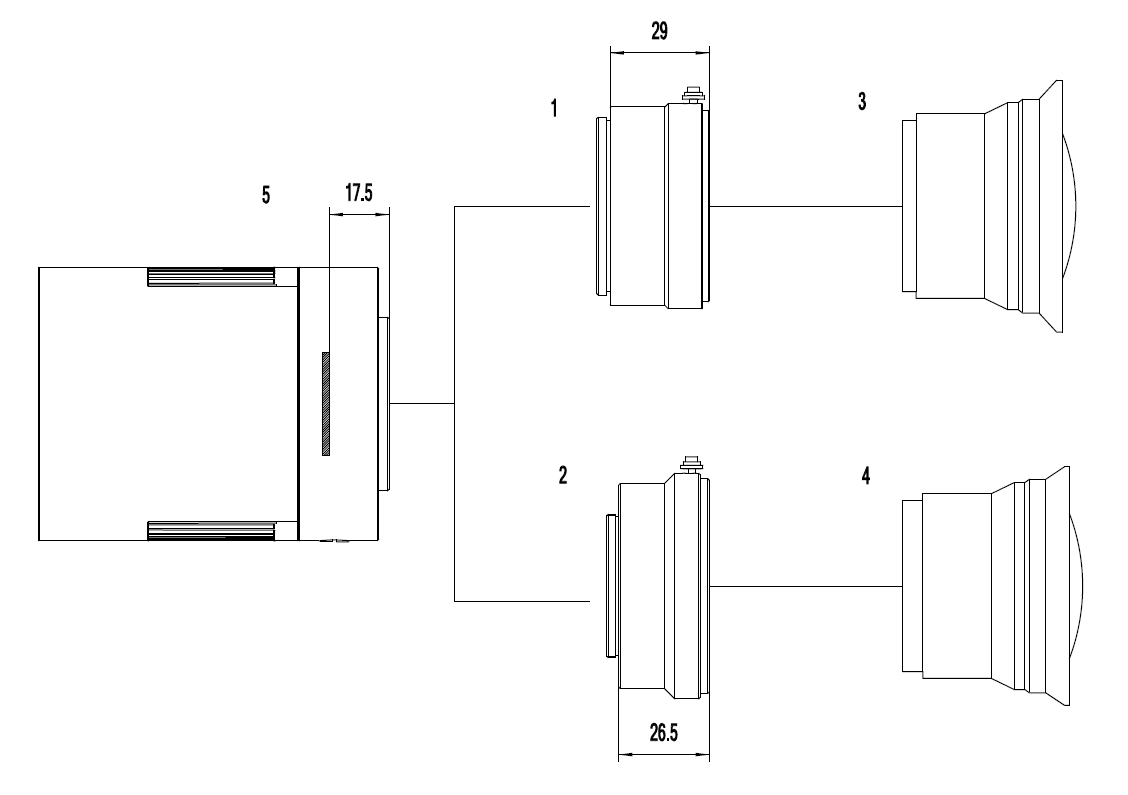 Figure 12 Nikon F/Canon EF Lens with ATR Camera
Figure 12 Nikon F/Canon EF Lens with ATR Camera
|
Item |
Specification |
|
1 |
Nikon F-M42 adapter (TBD) |
|
2 |
EOS EF-M42 adapter |
|
3 |
Nikon F-mount lens |
|
4 |
Canon EF-mount lens |
|
5 |
ATR camera with M42Fx0.75 mount |
3.6 Camera Electric Connection with Accessories
On the back side of ATR2110C, there are 3 connection ports: DC 12V/3A power port, USB3.0/ USB2.0 port and USB-HUB.
Due to the significantly larger power cunsumption of SC2110, ATR2110C (including the cooling system) is now booted up only by 12V/3A power supply. USB3.0 no longer works as a power source but only as a data communication method. The USB-HUB provides connection with other devices, which allows user to avoid the mess of cable management. Once another device is connected through the USB-HUB, it will be connected to PC device through the USB3.0/USB2.0 port.
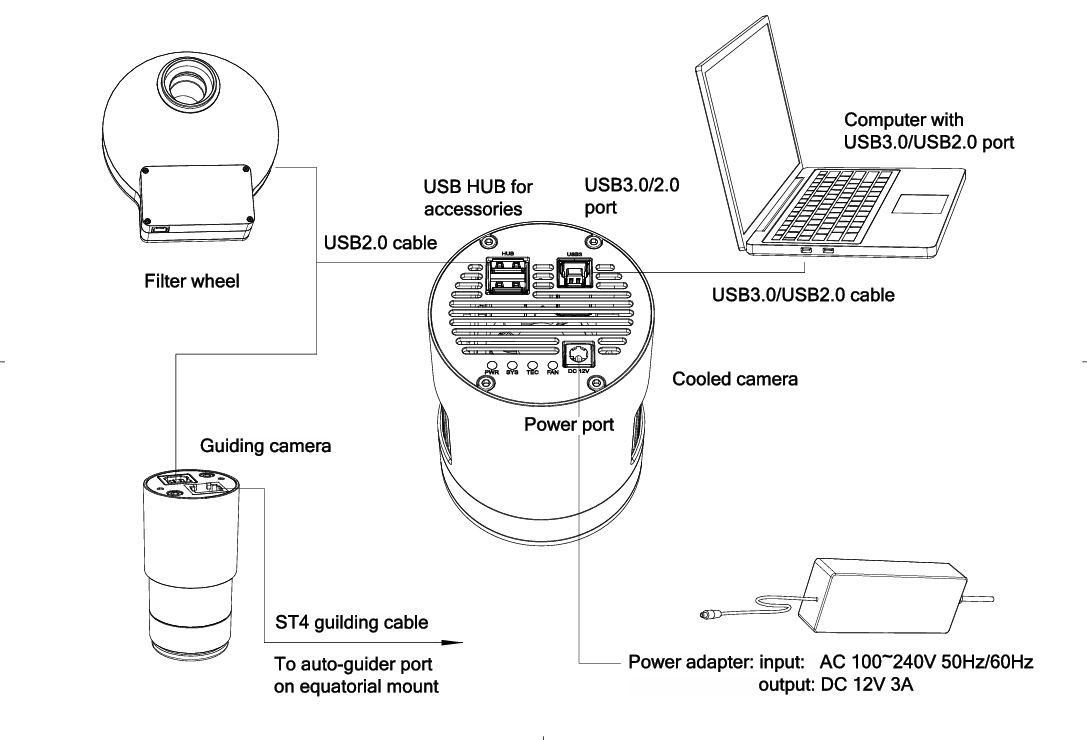 Figure 13 Camera Electric Connection
Figure 13 Camera Electric Connection
|
Item |
Specification |
|
USB3.0/USb2.0 Port |
To computer with USB3.0/USB2.0 cable |
|
USB HUB for Accessories |
To filter wheel with USB2.0 cable |
|
To guiding camera with USB 2.0 cable |
|
|
Power Port |
DC12V/3A |